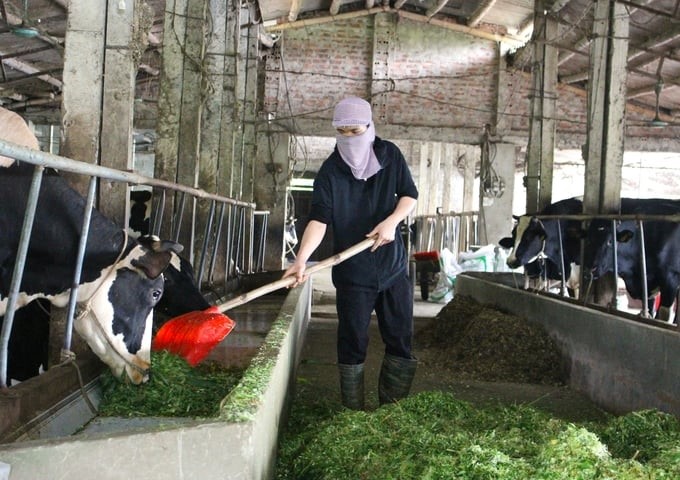June 20, 2025 | 00:07 GMT +7
June 20, 2025 | 00:07 GMT +7
Hotline: 0913.378.918
June 20, 2025 | 00:07 GMT +7
Hotline: 0913.378.918
According to the Ha Nam Sub-Department of Animal Husbandry and Veterinary Medicine, by the end of June 2024, the pig herd in the whole province is estimated to reach 385,000 heads, poultry of approximately 9 million heads, and buffalos and cows of more than 37,000 heads. The strong development of breed technology, along with farmers' access to and training in technical solutions through agricultural extension programs and projects, has helped the province's livestock industry make clear changes, increasing productivity and efficiency.

Ha Nam's livestock industry has made clear changes; however, developing biosafety farming still faces many difficulties. Photo: Trung Quan.
However, the transformation to farm-scale livestock farming is still slow, and the livestock linkage chain is loose and unsustainable.
Environmental pollution caused by livestock farming activities in some localities has not been thoroughly and effectively treated. Most livestock households build barns according to experience, so their barns are not technically guaranteed, causing difficulties in cleaning, disinfection, and sterilization.
Regarding breeds, there is still a small part of small-scale livestock households buying breeds that are not quarantined when first imported through traders. This is one of the great risks that lead to spreading and breaking out diseases, especially African swine fever disease.
Regarding feed, most livestock households use complete mixed feed for livestock. However, feed preservation is not guaranteed. Most do not arrange separate feed warehouses or have feed warehouses but do not have shelves; confuse feed with cleaning tools and veterinary medicine; and have no measures to prevent rats and insects from entering. Some households mix their own feed but cannot control the origin and quality of input grains such as corn, rice bran, soybeans, etc.
Faced with that reality, to develop livestock farming sustainably, the province's agricultural sector has promoted the construction of pilot models for biosafety farming on many different livestock objects so that professional staff as well as breeders can learn and apply.

Ha Nam's agricultural sector encourages the development of professional, farm-scale livestock farming. Photo: Trung Quan.
Besides, Ha Nam's agricultural sector also encourages the development of professional, farm-scale livestock farming. Accelerate the application of high and advanced technology in livestock farming, such as closed barn technology, biotechnology, automation in care, raising, disease management, etc. Widely apply artificial insemination technology in raising dairy cows, breeding cows, and pigs; continue to transfer techniques to increase the rate of artificial insemination in pig and poultry farming. At the same time, build disease-safe facilities and linkage chains of production, pre-processing, processing, and consumption of livestock products.
In addition, focus on bringing technology into livestock farming, strengthening consumption-market connections, creating stable output to stimulate production, diversifying the structure of livestock breeds, and creating favorable conditions for the application of biosafety measures in production.
Translated by Thu Huyen
![Turning wind and rain into action: [9] Digitizing hydrometeorological data in response to climate change](https://t.ex-cdn.com/nongnghiepmoitruong.vn/608w/files/news/2025/06/17/z6704423696987_15fd32ffc26d590d204d520c9dac6786-nongnghiep-165943.jpg)
(VAN) Farmers have begun accessing hydrometeorological applications to adjust their cropping schedules, aiming to ensure productivity and adapt to climate change.
![Turning wind and rain into action: [8] Real-time salinity detection and early warning technology](https://t.ex-cdn.com/nongnghiepmoitruong.vn/608w/files/news/2025/06/17/z6704423696987_15fd32ffc26d590d204d520c9dac6786-nongnghiep-151127.jpg)
(VAN) Thanks to the integration of modern hydrological-hydraulic models, remote sensing technologies, and artificial intelligence, the accuracy of hydrological forecasting has significantly improved.
![Turning wind and rain into action: [7] Early disaster warnings help marine farmers minimize losses](https://t.ex-cdn.com/nongnghiepmoitruong.vn/608w/files/news/2025/06/17/z6704423696987_15fd32ffc26d590d204d520c9dac6786-nongnghiep-142942.jpg)
(VAN) In recent years, thanks to early disaster warnings and forecasting, marine farmers in Khanh Hoa province have been able to reduce risks and losses, thereby improving production efficiency.
![Turning wind and rain into action: [6] ‘Four on-the-spot’ disaster management software](https://t.ex-cdn.com/nongnghiepmoitruong.vn/608w/files/news/2025/06/17/e5a48259d6a262fc3bb3-nongnghiep-183800.jpg)
(VAN) By simply activating the scenario on the disaster management software, the relevant authorities immediately know how many households need to be evacuated, where to evacuate them to, and by what means of transportation…
![Turning wind and rain into action: [5] Hue applies modern technology in disaster forecasting](https://t.ex-cdn.com/nongnghiepmoitruong.vn/608w/files/news/2025/06/17/z6704423696987_15fd32ffc26d590d204d520c9dac6786-nongnghiep-093938.jpg)
(VAN) In Hue city, modern technology has recently been applied in meteorological and hydrological forecasting and warning, helping to reduce the damage caused by natural disasters.

(VAN) A cutting-edge farming technique being implemented on an experimental ranch in Arizona's Sonoran Desert has already saved a billion gallons of water over five years, according to Civil Eats.

(VAN) Poultry and pig production and the environment can be boosted through enhanced water technology, according to new research.